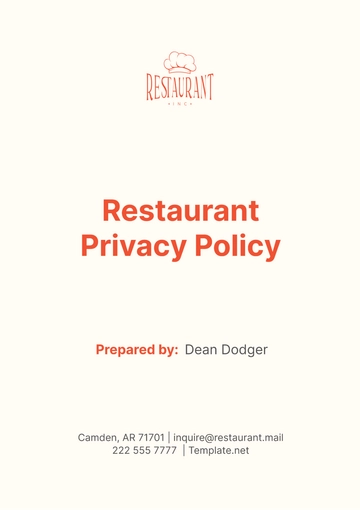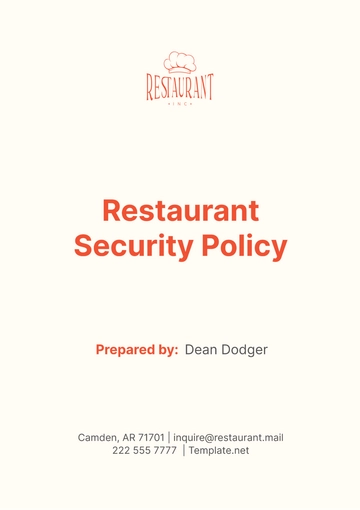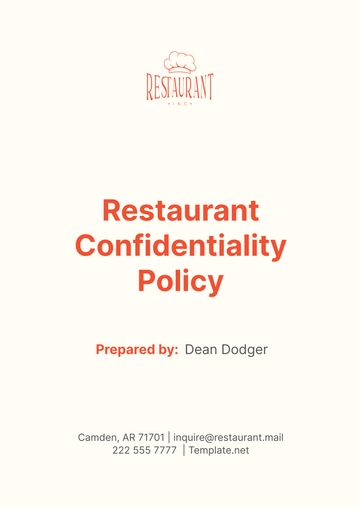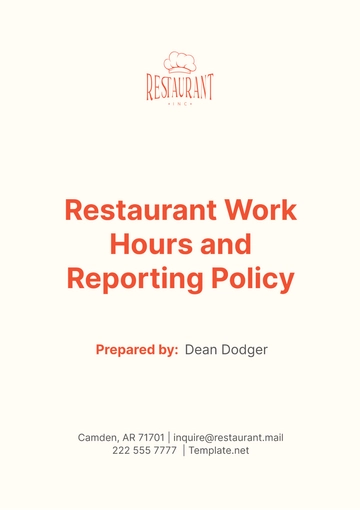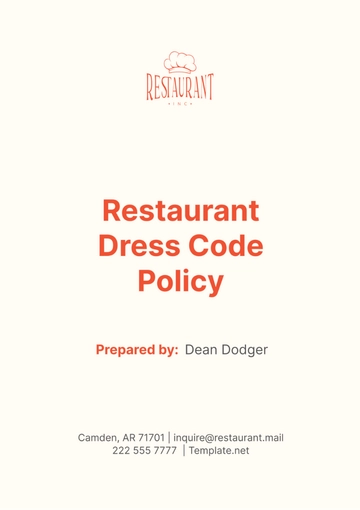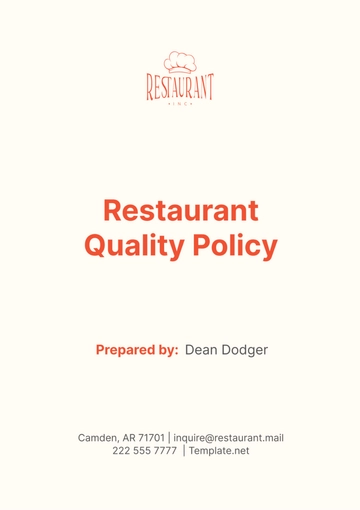Free Restaurant Maintenance Policy

I. Introduction
A. Purpose
The primary purpose of this policy is to establish a comprehensive standard operating procedure for maintaining the physical assets, equipment, and overall cleanliness at our restaurant. This is to ensure:
Safety: One of the key objectives of this policy is to ensure the safety of everyone who steps into our restaurant. Regular maintenance helps prevent accidents caused by faulty equipment or unsafe conditions.
Efficiency: Proper maintenance ensures that all our equipment and facilities are functioning optimally, which in turn allows our operations to run smoothly and efficiently.
Hygiene: In the restaurant business, hygiene is paramount. Regular cleaning and maintenance help us maintain high standards of cleanliness, contributing to the overall health and satisfaction of our customers.
B. Scope
The scope of this policy is broad, encompassing all aspects of our restaurant’s operations. It applies to:
Employees: All employees, regardless of their role, are expected to adhere to this policy. This includes kitchen staff, waitstaff, and management.
Contracted Maintenance Personnel: Any contracted personnel brought in for specific maintenance tasks are also required to follow the guidelines laid out in this policy.
Equipment, Fixtures, and Facilities: The policy covers the maintenance of all equipment, fixtures, and facilities used in daily operations. This includes everything from kitchen appliances to dining furniture, ensuring that every aspect of our restaurant is well-maintained.
II. Responsibilities
A. Management
Management holds a crucial role in the policy’s execution:
Training: Management is tasked with providing the maintenance staff with the necessary training. This ensures that they are equipped with the necessary skills and knowledge to carry out their duties effectively.
Resources: It is management’s responsibility to ensure that the maintenance staff has access to the required resources. This includes tools, cleaning supplies, and safety equipment.
Supervision: Regular supervision by management ensures that maintenance tasks are carried out correctly and safely. It also allows for timely feedback and correction of any issues.
Compliance: Management must ensure that all maintenance activities comply with this policy. This includes conducting regular audits and inspections to ensure adherence to the policy.
Inspections: Regular inspections by management help to identify any maintenance issues early. This allows for prompt action to be taken to resolve the issues, thereby preventing minor issues from becoming major problems.
B. Maintenance Staff
Maintenance staff are integral to our restaurant’s upkeep:
Regular Checks: Maintenance staff are responsible for performing regular checks of all equipment and facilities. This helps to identify any potential issues before they become major problems, ensuring the smooth operation of our restaurant.
Scheduled Maintenance: Maintenance staff must adhere to the maintenance schedule. Regular maintenance helps to prolong the life of our equipment and facilities, ensuring that our restaurant remains a safe and pleasant environment for everyone.
Issue Resolution: Any issues identified during checks or reported by other employees must be promptly addressed by the maintenance staff. This ensures that our restaurant remains safe and functional, and any potential disruptions to our operations are minimized.
Record Keeping: Maintenance staff are responsible for keeping accurate records of all maintenance activities. This helps to track the history of each piece of equipment and facility, providing valuable data for future maintenance planning and decision-making.
Safety: Maintenance staff must follow all safety guidelines when performing maintenance tasks. This ensures their safety and the safety of others, and helps to prevent accidents and injuries.
C. Employees
All employees play a part in maintaining our restaurant:
Vigilance: All employees should be vigilant in identifying potential maintenance issues or hazards. Early detection can prevent minor issues from becoming major problems, ensuring the safety and smooth operation of our restaurant.
Reporting: Employees are responsible for reporting any identified issues to management. This allows for prompt action to be taken to resolve the issue, ensuring that our restaurant remains a safe and pleasant environment for everyone.
Cooperation: Employees should cooperate with maintenance staff during maintenance activities. This may include moving out of certain areas or ceasing certain activities to allow maintenance tasks to be performed safely and efficiently.
Compliance: All employees must comply with the maintenance policy. This includes following any safety guidelines during maintenance activities, ensuring their own safety and the safety of others.
Feedback: Employees are encouraged to provide feedback on the maintenance policy. This can help to identify areas for improvement, ensuring that our maintenance policy remains effective and relevant.
III. Maintenance Schedule
A regular maintenance schedule is crucial in preventing issues and ensuring the longevity of our equipment and facilities. All equipment and facilities should be inspected and maintained according to the following schedule:
A. Daily
Daily checks are essential in maintaining the cleanliness and functionality of our restaurant. These checks should include:
Cleanliness and sanitation of kitchen and dining areas: Ensuring the cleanliness and sanitation of kitchen and dining areas is a daily necessity. This helps to maintain a hygienic environment and is crucial for the health and safety of both employees and customers.
Proper functioning of major kitchen equipment (e.g., stoves, ovens, fridges): Checking the proper functioning of major kitchen equipment ensures that our operations can run smoothly. Any issues can be identified and addressed promptly, preventing potential disruptions.
Emptying and cleaning trash containers: Regularly emptying and cleaning trash containers helps to maintain cleanliness and prevents odors and pest infestations.
B. Weekly
Weekly checks provide a deeper level of maintenance. These checks should include:
Deep cleaning of kitchen appliances: A weekly deep clean of kitchen appliances helps to maintain their efficiency and prolong their lifespan. It also ensures that our food preparation meets high standards of hygiene.
Inspection and sharpening of kitchen tools: Regular inspection and sharpening of kitchen tools ensure they are safe and effective to use. This contributes to the quality of our food and the efficiency of our kitchen operations.
Checking HVAC systems for proper function: Regular checks of the HVAC system ensure a comfortable and safe environment. Any issues can be identified and addressed promptly, ensuring the comfort of both employees and customers.
C. Monthly
Monthly checks allow us to address less immediate but equally important maintenance tasks. These checks should include:
Inspecting plumbing fixtures for leaks or issues: Regular inspection of plumbing fixtures can prevent water damage and high utility bills. Any leaks or issues can be addressed promptly, preventing potential damage and saving resources.
Checking and replacing air filters: Regularly checking and replacing air filters can improve air quality and the efficiency of our HVAC system. This contributes to a comfortable and healthy environment for both employees and customers.
Inspection of fire safety equipment (e.g., extinguishers, alarms): Regular inspection of fire safety equipment is crucial for the safety of our restaurant. This ensures that in the event of a fire, we are prepared to respond effectively.
D. Quarterly
Quarterly checks provide a comprehensive inspection of our restaurant’s infrastructure. These checks should include:
Comprehensive inspection of all electrical systems and wiring: Regular inspection of electrical systems and wiring helps to prevent electrical faults and potential fire hazards. Any issues can be identified and addressed promptly, ensuring the safety of our restaurant.
Checking the structural integrity of the building and fixtures: Regular checks of the building and fixtures help to maintain a safe and comfortable environment. Any structural issues can be identified and addressed promptly, preventing potential accidents and costly repairs.
IV. Standard Operating Procedures
Our Standard Operating Procedures (SOPs) provide a clear and detailed guide for all maintenance activities. Following these steps ensures that our maintenance activities are carried out safely and effectively:
No. | Step |
|---|---|
1 | Use of PPE |
2 | Equipment Check |
3 | Documentation |
4 | Waste Disposal |
5 | Cleanliness |
A. Use of PPE
The use of appropriate personal protective equipment (PPE) is a crucial first step in any maintenance task. PPE such as gloves, safety glasses, and protective clothing can protect maintenance staff from potential hazards such as sharp objects, hot surfaces, and harmful substances. By ensuring the safety of our staff, we can maintain a safe and productive work environment.
B. Equipment Check
Before starting any maintenance task, it’s important to ensure that all tools and equipment are in proper working condition. Using faulty equipment can lead to accidents, damage to the equipment or facilities, and ineffective maintenance work. Regular equipment checks also help to identify any tools that may need to be repaired or replaced.
C. Documentation
Documenting all maintenance activities in the maintenance log is a crucial part of our standard operating procedures. This record helps us track the performance and condition of our equipment and facilities over time. It also provides valuable information for planning future maintenance activities and identifying recurring issues.
D. Waste Disposal
Proper waste disposal is crucial for maintaining cleanliness in our restaurant and preventing environmental pollution. All waste materials generated during maintenance activities should be disposed of according to local regulations and our restaurant’s policies. This includes separating recyclable materials and disposing of hazardous waste in designated containers.
E. Cleanliness
After completing maintenance tasks, it’s important to ensure that the maintenance areas are left clean and functional. This not only maintains cleanliness in our restaurant but also ensures that we can resume normal operations as quickly as possible. Regular cleaning after maintenance activities also helps to prevent the accumulation of dirt and debris, which can cause further maintenance issues.
By following these standard operating procedures, we can ensure that our maintenance activities are carried out safely, effectively, and consistently. This contributes to the smooth operation of our restaurant, the longevity of our equipment and facilities, and the satisfaction of our customers.
V. Emergency Maintenance
Despite our best efforts, emergencies can still occur. In the event of an emergency maintenance issue, the following steps should be taken:
No. | Step |
|---|---|
1 | Contact Personnel |
2 | Evacuate |
3 | Document |
In the event of an emergency, it is crucial that these steps are followed promptly and accurately. This will ensure the safety of all individuals in the restaurant and minimize damage to our facilities and equipment.
A. Contact Personnel
The first step in any emergency is to contact the designated emergency maintenance personnel. These individuals are trained to handle a variety of emergency situations and can provide guidance on the necessary actions to take. Prompt contact with these personnel can help to mitigate the impact of the emergency and ensure a swift and effective response.
B. Evacuate
If the emergency poses a risk to individuals in the restaurant, the affected areas should be evacuated immediately. This ensures the safety of both our employees and customers. Clear evacuation procedures should be in place and all staff should be trained in these procedures to ensure a smooth and orderly evacuation.
C. Document
Once the immediate emergency has been addressed, it is important to document the issue and actions taken. This information should be recorded in the incident log. This documentation is crucial for reviewing the incident, identifying potential improvements to our procedures, and for insurance purposes. It also provides a record of the incident that can be used for training purposes to prevent similar incidents in the future.
Emergencies can be stressful and chaotic situations. However, by following these steps, we can ensure that we respond effectively and minimize the impact of the emergency. This contributes to the safety and resilience of our restaurant, and the well-being of our staff and customers.
VI. Policy Updates and Amendments
This Policy is a dynamic document that is subject to changes and updates to reflect the evolving needs of our restaurant, industry standards, and regulatory requirements.
A. Annual Review
An annual review of the policy is conducted to ensure its continued relevance and effectiveness:
Relevance Check: The policy is reviewed to ensure that it continues to align with the operational needs of our restaurant. This includes assessing whether the policy addresses all relevant areas of maintenance and whether any new areas need to be included.
Effectiveness Assessment: The effectiveness of the policy is assessed by reviewing maintenance records, incident reports, and feedback from staff. This helps to identify any areas of the policy that may need to be improved or clarified.
B. Regulatory Compliance
Ensuring compliance with health, safety, and regulatory standards is a key aspect of our policy:
Regulatory Updates: The policy is updated to reflect any changes in local health and safety regulations, industry standards, and any other relevant regulations. This ensures that our restaurant continues to comply with all regulatory requirements.
Compliance Checks: Regular compliance checks are conducted to ensure that all maintenance activities adhere to the policy. This includes conducting regular audits and inspections.
C. Policy Amendments
Any necessary amendments to the policy are made based on the findings of the annual review and compliance checks:
Amendment Process: Any necessary amendments to the policy are made in a systematic and documented manner. This ensures that all changes are well-documented and can be tracked.
Communication of Changes: Any updates or changes to the policy are communicated to all employees promptly. This ensures that all staff are aware of the current policy and can adhere to it.
- 100% Customizable, free editor
- Access 1 Million+ Templates, photo’s & graphics
- Download or share as a template
- Click and replace photos, graphics, text, backgrounds
- Resize, crop, AI write & more
- Access advanced editor
Create and implement effective maintenance practices with a customizable solution, the Restaurant Maintenance Policy Template brought to you by Template.net! This editable policy can be customized to reflect your restaurant’s maintenance standards without starting from scratch. The AI Editor Tool ensures clarity and precision in your policy document! Download now!
You may also like
- HR Policy
- Restaurant Policy
- Company Policy
- Accounting Policies and Procedures
- Website Policy
- Privacy Policy
- Safety Policy
- School Policy
- IT and Software Policy
- Law Firm Policy
- Construction Policy
- Interior Design Policy
- Travel Agency Policy
- Education Academic Policy
- Security Policy
- Real Estate Policy
- Expense Policy
- Software Policy






